Welcome all and sundry to another edition of the Mega Archive, digging up all manner of delicious details on the games released on the Sega Genesis/Mega Drive in chronological order. If you're just joining us, I've been tinkering with the pages for these games on our wiki to ensure it's fully covered for each of the major 16-bit consoles, and I figured I'd share what I've learned in these episodic game-by-game breakdowns. The Japanese Mega Drive library, to its benefit, has certainly been a lot more accessible overall than the Super Famicom's.
We're getting close to the end of 1991 now. This update will combine together the remaining November releases along with those with more nebulous release dates I couldn't narrow down much further than "the second half of '91". That'll free up the next update for all twenty games that debuted on the system in December: a bumper-sized finale for the 1991 Mega Drive and for this arc of the blog feature for 2019. I may have given myself a little more to bite off than I can chew workload-wise, but I guess we'll blast process that bridge when we get to it. For now, we've got ten November releases and five "at some point in 1991" releases to clear-up: this batch includes several more famous names from US developers and the last of the 1991 Sega Meganet "Game Toshokan" downloadable titles, including Sonic the Hedgehog's first ever spin-off.
Before we begin, let's (optionally) refresh ourselves on the 200+ Genesis games already processed:
- Part I: 001-020 can be found here.
- Part II: 021-035 can be found here.
- Part III: 036-050 can be found here.
- Part IV: 051-065 can be found here.
- Part V: 066-080 can be found here.
- Part VI: 081-098 can be found here.
- Part VII: 099-115 can be found here.
- Part VIII: 116-130 can be found here.
- Part IX: 131-145 can be found here.
- Part X: 146-160 can be found here.
- Part XI: 161-175 can be found here.
- Part XII: 176-190 can be found here.
- Part XIII: 191-205 can be found here.
Part XIV: 206-220 (November '91)
206: Pit-Fighter

- Developer: Tengen / Sterling Silver Software
- Publisher: Tengen
- JP Release: 1992-03-27
- NA Release: November 1991
- EU Release: February 1992
- Franchise: N/A
- Genre: Fighter
- Theme: Martial Arts
- Premise: Bloodsport was a good movie, but you know what it was missing? Van Damme getting hoisted up by a forklift after every victory.
- Availability: The original arcade version has shown up on several Midway compilations in the past, including most recently (2012) Midway Arcade Origins.
- Preservation: This was either a November or December release - GamePro has a "now available!" review in their December '91 edition, but a preview suggested a November date, so the truth is somewhere in between - but I figured I might as well start this update with a showstopper. Or, at least, Atari was hoping the state-of-the-art digitized sprite tech and the mystique of a lethal underworld fighting circuit was enough to impress a bloodthirsty crowd of arcade goers. Instead, the game is notorious over here for its goofy actors and notorious in Japan for silly translation errors, and notorious everywhere for its shoddy controls and hit detection, so no-one's really taking poor old Pit-Fighter too seriously.
207: John Madden Football '92
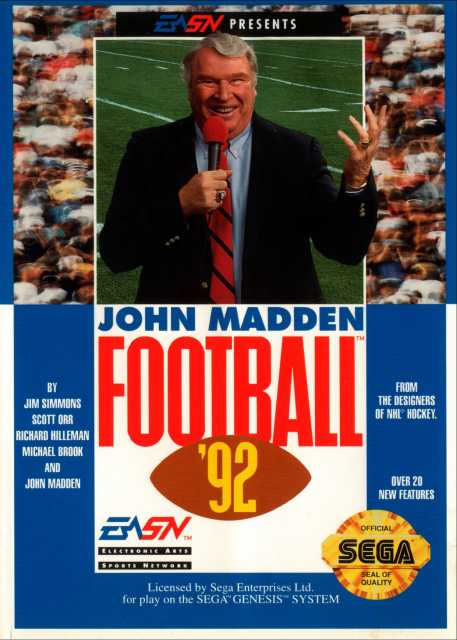
- Developer: Park Place Productions
- Publisher: Electronic Arts
- JP Release: 1992-11-20
- NA Release: November 1991
- EU Release: December 1991
- Franchise: Madden NFL
- Genre: Football
- Theme: Pro Sports
- Premise: Madden takes a break from telestrating in blood to tell us all about football in the second of EA's juggernaut sports franchise to hit the Genesis.
- Availability: It'd be wild if a modern Madden NFL just jammed a bunch of 16-bit Maddens in there as bonus extras, but I'm not sure that's happened yet.
- Preservation: I guess we'd better strap in for several more years of Madden sequels. I think this one's distinct for being the only core annual entry released on a single system (the Sega Genesis, but I guess that was obvious) instead of being multiplatform like every game previous and since, but I'm not 100% certain on that. An expected number of new tweaks and features as the franchise settles into its annual groove, most prominent being instant replays and two player co-op. (Later EA Sports games would innovate that screen where you move your controller icons to either of the two teams playing.) We don't have the NFL license yet so we've yet to attain the final form of "NFL Madden," but this iterative chapter is still a credit to the man who would put a pigskin inside a cowskin inside an elephantskin if someone would let him. I know very little about these games individually but '92's introduction of an ambulance that would barrel onto the field to collect injured players, injuring several others in the process, is legendary.
208: Shadow of the Beast
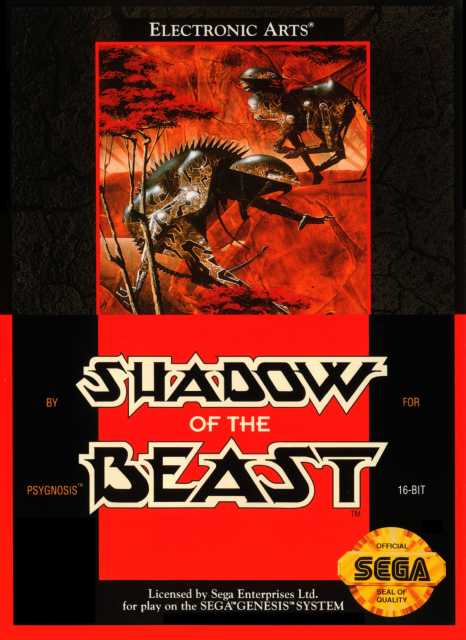
- Developer: WJS Design
- Publisher: Electronic Arts
- JP Release: 1992-03-27
- NA Release: November 1991
- EU Release: November 1991
- Franchise: Shadow of the Beast
- Genre: Brawler / Platformer
- Theme: Fantasy
- Premise: A kidnapped child is mutated into a mindless bestial footsoldier for a demon lord, but unexpectedly regains his humanity and decides to turn the tables on his former master.
- Availability: The 2016 reboot for PS4 includes the original Amiga game as a bonus extra, so that's probably the easiest (legal) method of playing it today.
- Preservation: Our sole UK representative (from what I can tell, port devs WJS Design was based in Leeds) for this edition of the Mega Archive is Shadow of the Beast: one of those "big deal" Amiga games that regularly mystifies console owners and/or Americans, given how awkwardly it plays. I never really understood its appeal either, but back when I had an Atari ST as my primary platform (which is basically the same as an Amiga, but don't let Amiga owners hear that from me) I noticed the type of games that were breathlessly reported in games magazines tended to be those that pushed the envelope in terms of visuals. Shadow of the Beast's art direction was inspired by British conceptual artist Roger Dean (who also did the cover art) which is striking to say the least. Likewise, it innovated lots of visual techniques like its extra layers of parallax scrolling and included a soulful soundtrack by David Whittaker, and I suspect the spectacle of the experience overwhelmed reviewers to the extent that they didn't seem to notice that the game had very little direction, was far too challenging, and didn't play so hot. Console ports like this, which lacked a lot of the visual tech and had to compete with the superior brawlers/platformers on those systems, sank without a trace. Didn't help that the NTSC versions of the Genesis port moved far too quick because the game was built for the PAL's slower refresh rate.
209: Trouble Shooter / Battle Mania
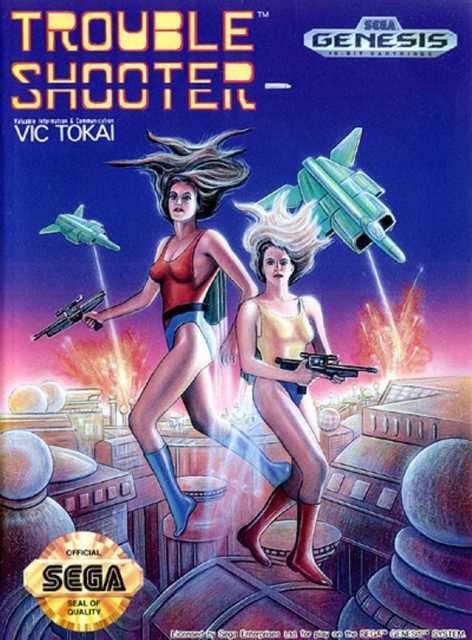
- Developer: Vic Tokai
- Publisher: Vic Tokai
- JP Release: 1992-03-06 (as Battle Mania)
- NA Release: November 1991 (as Trouble Shooter)
- EU Release: N/A
- Franchise: Battle Mania
- Genre: Shoot 'em Up
- Theme: Sci-fi
- Premise: A pair of female mercenaries take to the skies with their jetpacks in order to rescue a Prince.
- Availability: Sadly, original Genesis/MD cart only. Vic Tokai was a division of the much larger Tokai Corporation, which lost interest in developing or publishing games decades ago.
- Preservation: Trouble Shooter's one of the less serious shoot 'em ups for the Mega Drive, developed as it was as a love letter to madcap anime and to Dirty Pair (which also features a couple of destructive female "trouble consultants") in particular. Instead of a ship, the protagonist is a blonde girl in a jetpack named Madison who is flanked by her partner Crystal, the latter of whom acts as an adjustable "option". Crystal's invincible, but Madison is not, so the player has to keep an eye on bullets entering her vicinity while also adjusting Crystal's placement for the preferred damage output. The game has a silly sense of humor befitting its inspiration, demonstrated by bosses taunting you as you arrive and the way Madison casually disposes her convertible in the beginning of certain stages. Oddly, Vic Tokai brought out the game in the United States first before tweaking it for the Japanese Mega Drive release the following year. We'll see its Japan-only sequel in 1993, if the Mega Archive lasts that long.
210: Ys III: Wanderers from Ys

- Developer: Riot
- Publisher: Telenet Japan (JP) / Renovation (NA)
- JP Release: 1991-11-01
- NA Release: December 1991
- EU Release: N/A
- Franchise: Ys
- Genre: Action RPG
- Theme: Fantasy
- Premise: Adol "The Red" Christin, the baddest ass swordsman, follows his buddy Dogi to Dogi's hometown of Redmont to check out rumors of a monster invasion.
- Availability: Ys III was remade as Ys: The Oath in Felghana, currently available on Steam. I'd highly recommend it.
- Preservation: Hell yeah, an Ys game! Falcom's still-ongoing Ys franchise was a bigger presence on the SNES and TurboGrafx/PC Engine (both of which also saw a port of Ys III), but it did pop up on the Mega Drive for this single entry courtesy of Telenet Japan. Ys III has a harsh difficulty curve and some slightly antiquated mechanics to deal with, but the combination of its fast action and a great soundtrack makes it a lot more engaging than most of its immediate RPG ilk, if a little tactically weaker than the turn-based likes of Phantasy Star et al. Riot, the credited developer according to most of the internet, was a short-lived subsidiary of Telenet Japan; however, I'm not 100% certain whether they developed this port or simply published it in Japan.
211: Dragon's Eye Plus: Shanghai III
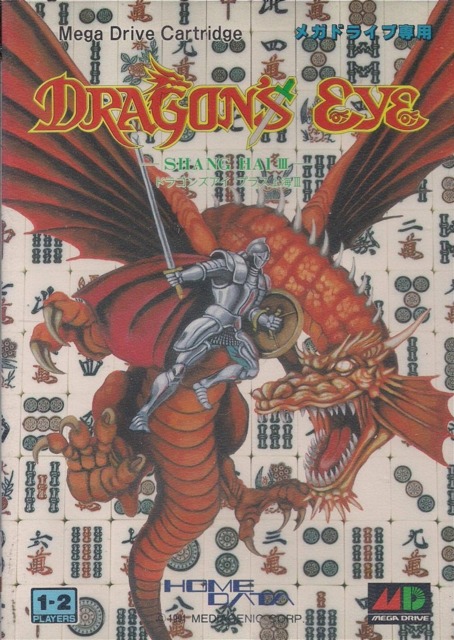
- Developer: Home Data
- Publisher: Home Data
- JP Release: 1991-11-02
- NA Release: N/A
- EU Release: N/A
- Franchise: Shanghai
- Genre: Mahjong Solitaire
- Theme: Chinese
- Premise: Medieval imagery comes to the time-honored format of mahjong solitaire. Are you ready for a knight on the tiles?
- Availability: Japanese Mega Drive only.
- Preservation: OK, so this gets a little convoluted. The Shanghai series of mahjong solitaire games started on PC in 1986 and was created by Activision. At some point they commissioned Home Data (known for their mahjong games, but the traditional four-player kind) to create a Mega Drive port of Shanghai II: Dragon's Eye, the second game in the series. Activision didn't care much for this port once they had their hands on it, so they made their own for the North American market a few years later using some in-house talent. It is also not to be confused with Shanghai III, which is a separate sequel: this port's name possibly comes from the fact that there was already a Shanghai II for the Game Gear at this time, or just poor intercontinental communication in general. For all the hoopla, it's really just a barebones version of mahjong solitaire with two tile sets you can switch between - traditional mahjong characters or medieval fantasy icons like unicorns and elves - and a handful of layout configurations.
212: Growl / Runark
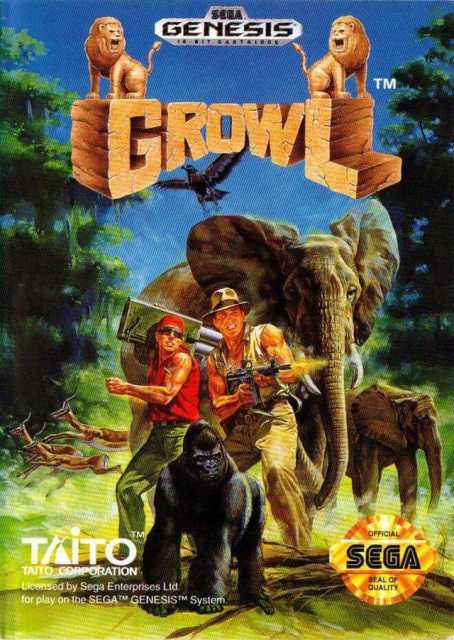
- Developer: ITL
- Publisher: Taito
- JP Release: 1991-11-15
- NA Release: 1991
- EU Release: N/A
- Franchise: N/A
- Genre: Brawler
- Theme: Alternate Historical
- Premise: Four rangers set out to dismantle an international poaching ring with the help of their animal friends and a whole lot of stolen military ordnance.
- Availability: The original arcade version was included on Taito Legends 2 for PS2 and Xbox.
- Preservation: I had never heard of this Indiana Jones-riffing anti-poaching brawler, but it looks to have taken the NARC route of taking some politically relevant message of the early '90s and twisting it into an excuse to murder a whole lot of elephant foot wastebasket crafters. It'd be like having the serious issue of South African apartheid and turning it into a violent Hollywood blockbuster where a high-ranking Afrikaner diplomat gets shot in the head. Perish the thought, right? Anyway, the Genesis port was severely compromised to the point of being unrecognizabe: the voice samples are gone, the graphics took a huge hit, it went from four-player simultaneous to just one-player (you love to see that in a brawler), and the protagonist's speed was reduced making it way easier for enemy groups to surround and stomp them into the dirt. Fun!
213: Rolling Thunder 2
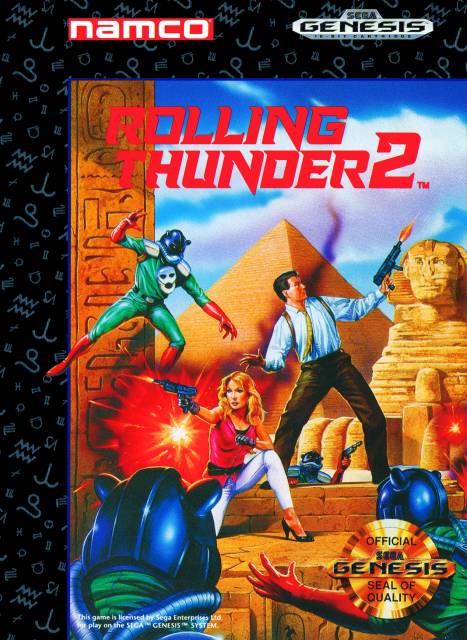
- Developer: Namco
- Publisher: Namco
- JP Release: 1991-11-19
- NA Release: February 1992
- EU Release: April 1993
- Franchise: Rolling Thunder
- Genre: Shooter
- Theme: Espionage
- Premise: Interpol agents Albatross and Leila are sent to demolish the newly rebuilt terrorist organization Neo-GELDRA.
- Availability: You can play the arcade version on Switch, via Namco Museum. It even includes the first Rolling Thunder.
- Preservation: Namco's back to roll coal and also roll thunder in this sequel to their arcade James Bond-inspired run-and-gun. Namco treated all three of the major 16-bit platforms to their fair share of exclusives, and of the three the Mega Drive would regularly see more of the direct arcade conversions (the SNES, in comparison, got most of the sports games and licensed games). Rolling Thunder, like Splatterhouse, would also eventually see a Mega Drive-exclusive second sequel that skipped the arcades entirely. The Rolling Thunder games are a bit like a 2D proto-Time Crisis as you're meant to make judicious use of natural cover to avoid getting shot, but you also have a strict time limit and so must balance caution and recklessness to get to the end of levels in time. The best part is the sound test available on the main menu: for whatever reason, the house band is full of weird little alien creatures.
214: Beast Wrestler / Beast Warriors

- Developer: Riot
- Publisher: Telenet Japan (JP) / Renovation (NA)
- JP Release: 1991-11-29 (as Beast Warriors)
- NA Release: March 1992 (as Beast Wrestler)
- EU Release: N/A
- Franchise: N/A
- Genre: Wrestling
- Theme: Monster Mash
- Premise: Two beasts enter an electrified deathmatch ring, one beast leaves. The other beast probably just flew off at some point. Beasts tend to be tricky like that.
- Availability: Telenet Japan's done a fine job burying this thing. The world was not yet ready for wrestling kaiju games and perhaps never will be. Well, besides King of the Monsters.
- Preservation: I'm already predisposed to greatly dislike any wrestling game (I'm kinda with Jeff here; isn't the draw of wrestling that all matches are determined ahead of time to befit storylines? Why are they fighting for real?) but even with the inclusion of burly tentacle creatures I still didn't warm up to this one. Considering the review scores it attained at the time, I don't think I'm alone. They'll have perfected the process of chokeslamming and DDTing weird gross bug monsters by the time Hybrid Heaven rolls around, fortunately. In the meantime, Genesis owners are going to have to deal with the absence of a good wrestling game for a little while longer yet.
215: Ransei no Hasha
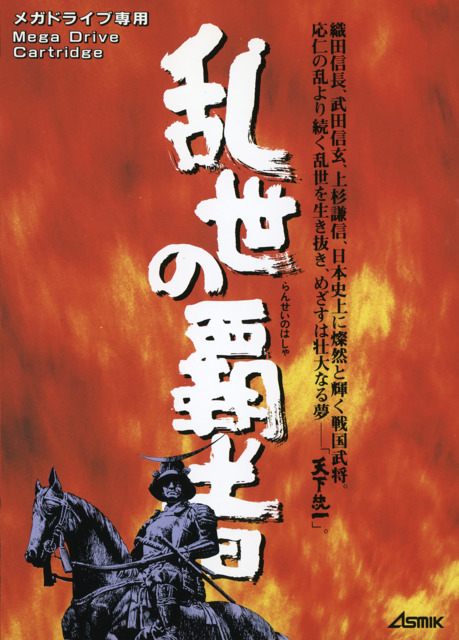
- Developer: SPS
- Publisher: Asmik Ace
- JP Release: 1991-11-29
- NA Release: N/A
- EU Release: N/A
- Franchise: N/A
- Genre: Strategy
- Theme: Sengoku Japan
- Premise: Sixteenth century Japan is in disarray. Quick, take the whole place over while no-one is looking!
- Availability: No idea who could bring this game back or why they would want to.
- Preservation: Ransei no Hasha, which means "Conquerer of Troubled Times" (Ransei doesn't seem to refer to a specific period of Japanese history, more a generic term for the chaotic parts in-between dynasties - it was later used for the region name for the Pokémon Conquest spin-off), is clearly modelled on the classic Koei blueprint of turn-based strategy wargaming, with all the concomitant rice shortages and civil unrest to worry about between battles. I can barely make heads or tails of this type of game even when they're in English, but it doesn't seem like a very engaging one of these. The more learned parts of the retro gaming internet believes that this is a sequel/spin-off of a SystemSoft Sharp X68k game, Tenka Touitsu, but those are some real choppy waters to try and navigate without Japanese fluency.
216: Robot Battler

- Developer: Sega
- Publisher: Sega
- JP Release: 1991
- NA Release: N/A
- EU Release: N/A
- Franchise: N/A
- Genre: Action
- Theme: Robots
- Premise: Why create robots to help us evolve and prosper as a civilization when we could just make them hit each other?
- Availability: It's on the Game no Kanzume Otokuyou compilation, if you felt like getting a Sega Mega Drive Mini (Japan or Asian edition) to play it on.
- Preservation: We're back for our final block of Game Toshokan titles, those once available exclusively through the Japan-only Sega Meganet (a precursor to the Sega Channel). Robot Battler is a very barebones take on a Custom Robo type of game where you build up your robot ahead of time by distributing stats and equipment, limited to some fixed totals, and then must overpower an opponent in the arena. One major quality is that the game is two-player, which is a step beyond what a lot of these simple Games Toshokan allowed, but I don't think the game has much depth to it. Maybe you unlock better weapons and higher stat ceilings as you chalk up victories in the single-player, but the multi's more about building a robot to your preferred specifications and letting loose on a pal rocking their own ideal build.
217: Sonic Eraser
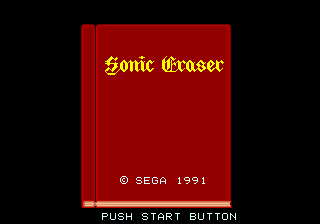
- Developer: Sonic Team
- Publisher: Sega
- JP Release: 1991
- NA Release: N/A
- EU Release: N/A
- Franchise: Sonic
- Genre: Puzzle
- Theme: Hedgehogs
- Premise: Have you ever played Sonic '06 or Sonic Heroes or Sonic Boom or Sonic Adventure 2 or Sonic and the Black Knight or (you get the picture) and thought about erasing the blue 'hog from the timeline to spare humanity from its suffering? Well, is this the monkey's paw wish for you.
- Availability: Sadly not. It was rumored to have been considered for the PS2/GameCube Sonic Gems Collection as a bonus freebie, but I guess someone at Sega/Sonic Team decided against it.
- Preservation: Our first (of many) Sonic the Hedgehog spin-offs, Sonic Eraser is a mere whiff of a game but a premonition of the great things in store for Sonic's future adventures. I say great, but I can't actually think of a good Sonic spin-off: Sonic Spinball? Sonic 3D Blast? Sonic R? Sonic Shuffle?! Maybe Sonic Team should've have stopped here with this simple and inoffensive block-matching puzzle game while they were still ahead. (My personal favorite part of this game is when you get a combo chain and Sonic sprints across the screen to smack his doppelganger in the mouth.)
218: Teddy Boy Blues
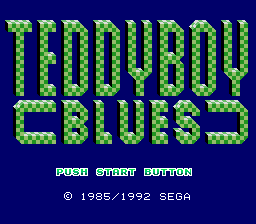
- Developer: Sega
- Publisher: Sega
- JP Release: 1991
- NA Release: N/A
- EU Release: N/A
- Franchise: N/A
- Genre: Action
- Theme: Toys
- Premise: Some melon-headed rugrat with a peashooter is being kept awake by his toy collection. Only reasonable course of action is to break everything.
- Availability: It's also on the Game no Kanzume Otokuyou compilation and by extension the Japanese/Asian Mega Drive Mini.
- Preservation: Teddy Boy Blues, referring to a fashion trend in 1950s UK (and specifically to a song by pop singer Yoko Ishino, who I guess was used to promote the game), is one of the few Sega Meganet games that was a recycled arcade game that Sega plucked out from their storage closet for their undemanding online service. I think the only other one of those was Flicky; every other Sega Meganet game was created specifically for it. As you might expect from a 1985 arcade game, it's not particularly complex but it is playable enough. The goal is to shoot enemies that pop out of alarm clocks at set intervals and you can destroy parts of the level (which wraps around both horizontally and vertically) to give both yourself and your enemies an easier route through, a little like Nintendo's Ice Climber. To Sega's credit, they could've easily just ported over the Master System version (or the arcade original) but instead created all-new graphics and character sprites.
219: Art Alive
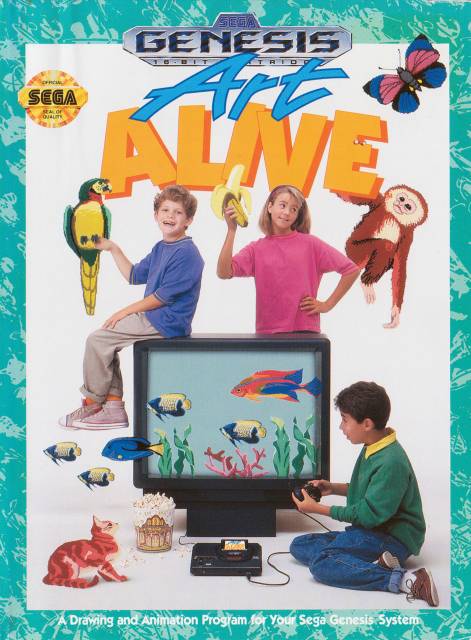
- Developer: Western Technologies / FarSight Studios
- Publisher: Sega
- JP Release: 1992-03-27
- NA Release: 1991 (Q4?)
- EU Release: March 1992
- Franchise: N/A
- Genre: Utility
- Theme: Art
- Premise: Genesis owners are introduced to a world of artistic self-expression while I'm introduced to yet another conundrum about whether or not a glorified paint tool deserves a wiki page.
- Availability: Bring up the Run command on your PC, type "mspaint" and you're golden.
- Preservation: I don't know what it is about working on the pages of these art programs, but I'm always compelled to pen a poorly-drawn image of Bomby, the Giant Bomb Mascot, in the program and then add it to the page's header image. It's probably for the best no-one ever visits those pages because they're far from my most professional work. Art Alive is older than Mario Paint, and it's also considerably less feature-rich: there's no music composition program, nor can your animations get more elaborate than four frames. It's obviously also missing the fly-swatter mini-game, which might be the only reason Mario Paint gets a pass on our wiki (and why something like Art Alive is more of a gray area).
220: Mario Lemieux Hockey
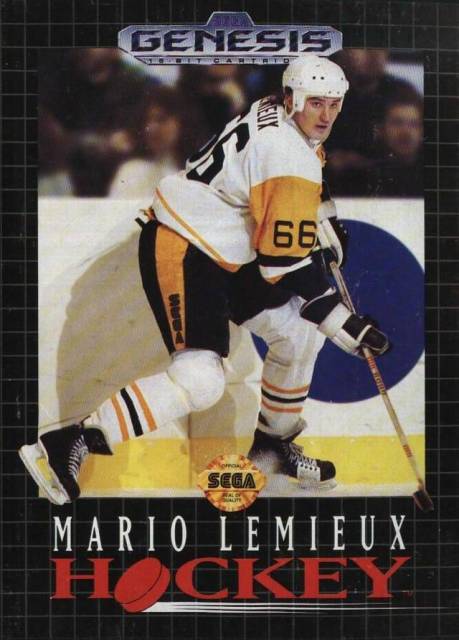
- Developer: Ringler Studios
- Publisher: Sega
- JP Release: N/A
- NA Release: 1991 (Q4?)
- EU Release: March 1992
- Franchise: N/A
- Genre: Hockey
- Theme: Pro Sports
- Premise: The Pittsburgh Penguins champ lends his unpronounceable name (it's "lah-mew", I got it) to this hockey sim.
- Availability: Ringler Studios was purchased by MicroLeague in '96, who themselves are now an educational software company after a bankruptcy and corporate reshuffle, so let's assume this IP has been put on ice indefinitely.
- Preservation: I'm not going to make a second ice pun about preservation, but I will say that Mario Lemieux Hockey is a noble attempt to break into a market EA was already in the process of cornering, which is the market of "all the sports". NHL Hockey was still in its nascency, and most hockey games like Mario Lemieux Hockey and those that came prior rocked the horizontal perspective that could cover more of the rink at once and made it easier to know where the puck was at all times. It's kind of a miracle that EA got away with their vertical view for as long as they did. Even with a big Canadian sports star name attached and a dedicated mode for just the fighting I don't believe this game managed to wrest enough EA NHL fans away. Hence why there was never a Mario Lemieux Hockey 2 (or a Mario Lemieux Hockey '93, as sports game naming conventions would demand).
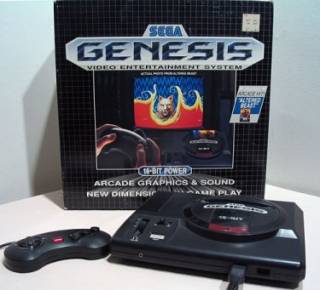
Log in to comment